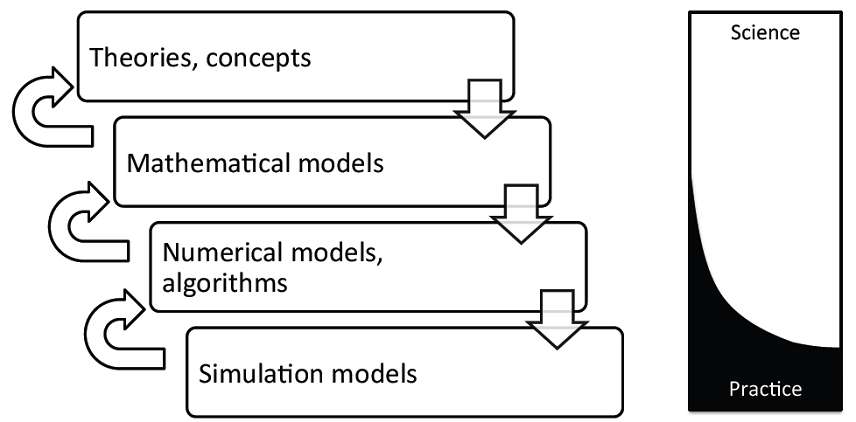Background
Over the past decades, traffic simulation models have become key tools for transport and traffic practitioners, policymakers and academics all over the world. Many of the commercial software packages available have their origins in the academic world, but are now developed and distributed by specialized software companies. Figure 1 outlines the (ideal) cyclic process of traffic simulation model development. The cycle starts with a conceptual idea such as conservation of vehicles (CoV), or the idea that drivers adjust their speed proportional to the (perceived) distance headway required to safely avoid collisions. Such concepts can be mathematically formulated in many forms. For example, the CoV principle can be formulated as a system of partial differential equations in Lagrangian or Eulerian coordinates. Both implement the same idea, but have different mathematical characteristics. To solve these equations for large realistic traffic networks numerical approximations are required. Again we have a one-to-many relationship, because there are different numerical approaches (implicit, explicit, first or higher order, etc) available to solve the same system of equations, which differ in accuracy and computational complexity. Also in the final development step (from numerical model to actual simulation software), many additional choices must be made, such as object and data representation, simulation scheduling, error handling, etc. All these choices (theory -> mathematics -> numerical solutions -> software code) potentially affect the (application-specific) validity of the simulation.
In an ideal world academia and practice collaborate continuously along the lines sketched in Figure 1. In the real world, however, there is little to no interaction between academia and practice once simulation software is commercialized. Particularly microscopic traffic simulation packages are black boxes, in which it is impossible to unravel which underlying mathematical and numerical choices have been made, and what the consequences of these are in terms of model validity. This black-box problem essentially forces most academic researchers to reinvent the wheel and to code an entire simulation model from scratch, even in case the research objective is to develop a very specific innovation (e.g. a new car following model). This entails huge additional efforts (e.g. visualisation, input-output data processing) that (a) have nothing to do with the innovation itself and (b) seldom lead to robust reusable (and publishable) simulation code. As a result, many scientific innovations in our field are not implemented (or even considered) in commercial simulation software. Even within academia, it is often difficult to reuse simulation code after e.g. PhD students have finished their research.
A second problem relates to incompatibility of the model inputs. Most commercial simulation packages store, retrieve and process input (network description, origin-destination flows, control scenarios) and internal structures in native formats and files. This frustrates the portability of data (inputs, networks, origin-destination (OD) flows, etc) between traffic simulation packages, and severely limits the possibilities for multi-scale modelling. A third problem is that the gap between science and practice also affects other processes related to traffic simulation, such as the estimation of OD matrices, and methodologies for ex post or ex ante evaluation using simulation models.

Figure 1: The (ideal) development cycle of simulation models
Multi-scale concept
Traffic models can be designed with various approaches. The generation of demand may be based on an activity based approach or a gravity model. And the assignment of trips can be done very detailed for instance by a micro-simulation or more globally, for instance a macroscopic type of assignment. The object design in the Open Traffic system is intended to support both detailed but also more aggregated and global approaches. Essentially, we derive our object definitions from the requirements of the detailed approach of modelling traffic demand, for that is for instance used for activity based modelling and micro simulation. By aggregating these objects they become suitable for other approaches. With respect to objects with a fixed geography, a linkage to the topology and semantics of Geographic Information Systems is highly favoured.
Multi-modal concept
Movements and the way to model them, varies between modes. Vehicle behaviour significantly differs from pedestrian behaviour and requires other approaches. Likewise, aeroplane movements deviate due to the additional vertical dimension. One of the objectives of Open Traffic is to provide a generic environment that is suitable for all of these modes.